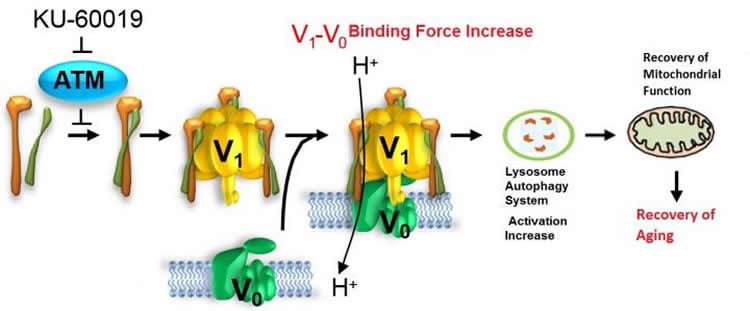Summary: A new study reports researchers have identified a substance that can help to induce the reversal of aging.
Source: DGIST.
Researchers confirm the reversal of cell aging progresses.
DGIST’s research team discovered substances that can induce reversible aging recovery and identified an aging recovery mechanism using these substances.
Aging is a phenomenon in which a cell’s ability to divide and grow deteriorates as it gets older, and this causes degradation of the body and senile diseases. The inhibition and recovery of aging is an instinctive desire of humans; thus, it is a task and challenge of biologists to identify substances that control aging and analyze aging mechanisms.
DGIST’s research team have been conducting research to reverse the aging process by shifting the existing academia’s ‘irreversibility of aging’ paradigm, which means aging cannot be reversed.
To reverse the aging process, the research team searched for factors that could control aging and tried to discover substances that could restore cell division capacity. As a result, it was confirmed that KU-60019, an inhibitor of ATM protein, which is a phosphorylation enzyme, recovers the functions of aging cells through activation of lysosomal functions and induction of cell proliferation.
The degradation of lysosomes, which are intracellular organelles responsible for autophagy and decomposition of biopolymers such as proteins and lipids in the cell, leads to cell senescence by accumulating biomolecules that must be removed in cells and causes instability of the metabolism such as removal of dysfunctional mitochondria that do not function.
The research team was the world’s first to confirm that as cell aging progresses, the vacuolar ATPase (v-ATPase) protein involved in the lysosomal activity regulation is phosphorylated by the ATM protein, and the binding force between the units constituting the v-ATPase is weakened, so consequently the function of lysosomes deteriorates.

In addition, the team has proven that the reversible recovery of aging is possible through its experiment that shows the regulation of ATM protein activation by KU-60019 substances induces the reduction of phosphorylation of v-ATPase, thereby inducing recovery of mitochondrial function and functional recovery of the lysosome and autophagy system as well as promoting wound healing in aging animal models.
DGIST Chair Professor Park SangChul said, “The significance and implication of this study is that it is possible to reverse the recovery of aging cells by inhibiting and restoring the degradation of lysosomal function. In the future, we will continue to conduct studies that extend the life expectancy of human beings by verifying and validating efficacy and safety through aging animal models.”
Reversible aging: In a chemical reaction, when two substances are reacted at a specific concentration, pressure, temperature, etc., and a product is made, the reaction in which the first two substances are formed after reacting this product is called a reversible reaction. On the other hand, reactions that occur only in one direction are called irreversible reactions. Instead of seeing the aging of living organisms as they grow older as irreversible and inevitable, they see it as reversible and restorable; thus, the term ‘reversible aging’ is used to denote such a reaction.
Source: Jamie Deasy – DGIST
Image Source: NeuroscienceNews.com image is credited to DGIST.
Original Research: Abstract for “Chemical screening identifies ATM as a target for alleviating senescence” by Hyun Tae Kang, Joon Tae Park, Kobong Choi, Yongsub Kim, Hyo Jei Claudia Choi, Chul Won Jung, Young-Sam Lee & Sang Chul Park in Nature Chemical Biology. Published online March 27 2017 doi:10.1038/nchembio.2342
[cbtabs][cbtab title=”MLA”]DGIST “Reverse Aging Now Possible.” NeuroscienceNews. NeuroscienceNews, 3 April 2017.
<https://neurosciencenews.com/reverse-aging-atm-protein-6331/>.[/cbtab][cbtab title=”APA”]DGIST (2017, April 3). Reverse Aging Now Possible. NeuroscienceNew. Retrieved April 3, 2017 from https://neurosciencenews.com/reverse-aging-atm-protein-6331/[/cbtab][cbtab title=”Chicago”]DGIST “Reverse Aging Now Possible.” https://neurosciencenews.com/reverse-aging-atm-protein-6331/ (accessed April 3, 2017).[/cbtab][/cbtabs]
Abstract
Chemical screening identifies ATM as a target for alleviating senescence
Senescence, defined as irreversible cell-cycle arrest, is the main driving force of aging and age-related diseases. Here, we performed high-throughput screening to identify compounds that alleviate senescence and identified the ataxia telangiectasia mutated (ATM) inhibitor KU-60019 as an effective agent. To elucidate the mechanism underlying ATM’s role in senescence, we performed a yeast two-hybrid screen and found that ATM interacted with the vacuolar ATPase V1 subunits ATP6V1E1 and ATP6V1G1. Specifically, ATM decreased E-G dimerization through direct phosphorylation of ATP6V1G1. Attenuation of ATM activity restored the dimerization, thus consequently facilitating assembly of the V1 and V0 domains with concomitant reacidification of the lysosome. In turn, this reacidification induced the functional recovery of the lysosome/autophagy system and was coupled with mitochondrial functional recovery and metabolic reprogramming. Together, our data reveal a new mechanism through which senescence is controlled by the lysosomal–mitochondrial axis, whose function is modulated by the fine-tuning of ATM activity.
“Chemical screening identifies ATM as a target for alleviating senescence” by Hyun Tae Kang, Joon Tae Park, Kobong Choi, Yongsub Kim, Hyo Jei Claudia Choi, Chul Won Jung, Young-Sam Lee & Sang Chul Park in Nature Chemical Biology. Published online March 27 2017 doi:10.1038/nchembio.2342







